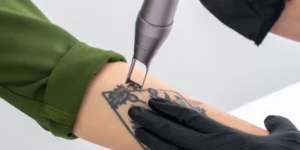Embarking on the path of tattoo removal often transcends the physical realm, intertwining with an emotional journey that is deeply personal and multifaceted. Tattoos, often inked as symbols of memories, beliefs, or phases of one’s life, can become entwined with one’s identity and emotional state. Consequently, the decision to remove them can unleash a cascade of emotions, ranging from relief and liberation to regret and melancholy. In this exploration, we delve into the emotional tapestry of tattoo removal, seeking to understand and navigate the psychological ebbs and flows encountered along the way.
Chapter 1: The Motivations Behind Tattoo Removal
The motivations propelling individuals towards tattoo removal are as varied as the tattoos themselves. It might stem from a desire to erase a painful memory, to align one’s external appearance with evolved beliefs, or to make space for new beginnings. Understanding and acknowledging these motivations is the first step in navigating the emotional journey, providing a foundation upon which to build support and resilience.
Chapter 2: Anticipation and Anxiety
The period leading up to the commencement of tattoo removal can be fraught with anticipation and anxiety. Questions regarding pain, outcomes, and potential regrets might swirl, creating a vortex of apprehension. Engaging in thorough research, consulting with qualified specialists, and establishing a support network can mitigate these anxieties, providing a cushion of reassurance and preparedness.
Chapter 3: Pain, Discomfort, and Resilience
The physical pain and discomfort experienced during tattoo removal can reverberate into emotional realms, potentially unearthing feelings of vulnerability, frustration, or impatience. Recognizing the resilience that emerges through enduring this physical and emotional discomfort can be empowering, transforming pain into a testament of strength and commitment to one’s chosen path.
Chapter 4: The Emotional Rollercoaster of Progress
The journey of tattoo removal is often elongated, spanning multiple sessions over several months or years. The gradual fading of the tattoo can trigger a spectrum of emotions, from elation at witnessing its diminishment to impatience or disappointment with the pace or extent of progress. Maintaining a perspective that embraces patience and celebrates incremental achievements can provide emotional sustenance throughout this prolonged journey.
Chapter 5: Grief and Letting Go
As the tattoo fades, it might evoke feelings of grief, even if the removal is a conscious and desired choice. The tattoo, once a permanent fixture, may have been a marker of a particular phase, belief, or memory, and its disappearance can signify a form of loss. Allowing space to grieve, while also focusing on the liberation that comes with letting go, facilitates a healthy emotional transition.
Chapter 6: Liberation, Regret, or Both?
Upon the completion of the removal process, emotions might cascade into a paradox of liberation and regret. While the erasure of the tattoo might bring relief and a sense of freedom, it might also be tinged with nostalgia or regret. Acknowledging and accepting this emotional duality, without judgment, enables a wholesome embrace of the journey’s conclusion.
Chapter 7: Reflection and Rebirth
The conclusion of the tattoo removal process opens a portal to reflection and rebirth. It provides an opportunity to contemplate the journey, with its myriad of emotions, challenges, and triumphs, and to explore the emotional and physical space that has been created. Whether it becomes a canvas for new ink, a testament to one’s evolution, or simply a cherished chapter in one’s story, the conclusion is a personal tapestry of reflection and renewal.
Embracing the Emotional Tapestry
The emotional journey of tattoo removal, with its intricate weave of motivations, pain, progress, grief, liberation, and reflection, is a deeply personal narrative. By acknowledging, respecting, and navigating each emotional phase with compassion and support, the journey transcends the physical realm, becoming a pathway to emotional growth, self-discovery, and, ultimately, healing.




